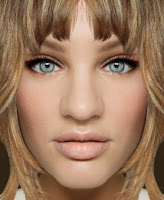The Perfect Face, part 1
Published on August 29, 2024 by Kyle Yamamoto
Often when I talk to patients about what results they want
to see, the topic of “the perfect face” comes up. What do we consider
perfect? Does each person have a
different idea of perfection? This is obviously a very complex topic that we
could write entire books about, but I think a good place to start is with
symmetry.
to see, the topic of “the perfect face” comes up. What do we consider
perfect? Does each person have a
different idea of perfection? This is obviously a very complex topic that we
could write entire books about, but I think a good place to start is with
symmetry.
Symmetry means that both sides (the right half and the left
half) of the face are perfect mirror images of each other. Asymmetry means that
each side of your face is unique and different from the opposite side. While some
asymmetries are more obvious (e.g. the nose is crooked, one ear is larger than
the other) others are much more subtle. Close examination of a face will show
slight differences when it comes to the intricate structures of the face,
including the eyes, ears, mouth, cheeks, chin, and nose.
half) of the face are perfect mirror images of each other. Asymmetry means that
each side of your face is unique and different from the opposite side. While some
asymmetries are more obvious (e.g. the nose is crooked, one ear is larger than
the other) others are much more subtle. Close examination of a face will show
slight differences when it comes to the intricate structures of the face,
including the eyes, ears, mouth, cheeks, chin, and nose.
In reality, there is no such thing as a perfectly symmetric
human face. You could search the Earth
for a face that is the best candidate and find out that it is not
symmetric. The best way to explain this
idea is to give you an example.
human face. You could search the Earth
for a face that is the best candidate and find out that it is not
symmetric. The best way to explain this
idea is to give you an example.
Let’s take a look at Candice, one of the world’s most famous
supermodels:
supermodels:
Her face looks pretty darn symmetric.
Now I have drawn a line down the middle of her face and
produced two new photos, one with her left side of her face mirrored on the
right, as well as two rights of her face mirrored the same way:
|
|
|
Here’s another example with original, two lefts, and two
rights:
rights:
|
|
|
|
Now, going back to look at the original photos, you can start to notice slight differences in the shape of the eyes, straightness of the nose, structure of the lips, and curvature of the jawline. And this is in one of the more “perfect” faces we know! Her original photos don’t seem so symmetric anymore.
Notice that while the mirrored photos resemble Candice, they
don’t exactly look like her. The other photos
could be seen as a totally different person. The
mirrored photos can also be, arguably, interpreted as looking strange or
odd. I believe that this is because, we
as humans, are not trained to look at perfectly symmetric faces. Probably
because they don’t exist!
don’t exactly look like her. The other photos
could be seen as a totally different person. The
mirrored photos can also be, arguably, interpreted as looking strange or
odd. I believe that this is because, we
as humans, are not trained to look at perfectly symmetric faces. Probably
because they don’t exist!
Now keep in mind that the photo itself can lend to some
inherent asymmetries if the model’s face is not perfectly in line with the camera
angle. But that is precisely the point! In the real world, we never look at
someone’s face exactly straight-on. We always see faces at somewhat of an
angle. Therefore, a perfectly symmetric face is actually necessary in that we
would never truly observe it with our own eyes.
inherent asymmetries if the model’s face is not perfectly in line with the camera
angle. But that is precisely the point! In the real world, we never look at
someone’s face exactly straight-on. We always see faces at somewhat of an
angle. Therefore, a perfectly symmetric face is actually necessary in that we
would never truly observe it with our own eyes.
In pursuit of the “perfect face” we need to remember that it
does not exist in the literal sense of the word. When it comes to perfect symmetry, it cannot
be achieved, nor should it be sought after. Candice is a great example that asymmetry
is unique, individual, and beautiful. Those are the types of qualities we are
striving for.
does not exist in the literal sense of the word. When it comes to perfect symmetry, it cannot
be achieved, nor should it be sought after. Candice is a great example that asymmetry
is unique, individual, and beautiful. Those are the types of qualities we are
striving for.
In future blogs, I will address other aspects of “the
perfect face.” Next up, what is the most
desirable look for specific parts of the face, and which celebrity face is the closest to perfect?
perfect face.” Next up, what is the most
desirable look for specific parts of the face, and which celebrity face is the closest to perfect?
Here’s to the beautiful human face,
-Dr. Yamamoto






